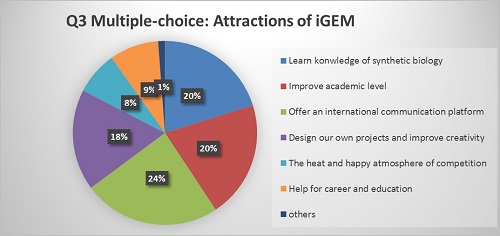Team:SCUT/HP/Practical analysis
From 2014.igem.org


In the report, the application of Synthetic Biology in production and public common life has been highly stressed. Meanwhile, it demonstrates the summary of public’s attitudes towards the above application, as well as the related knowledge on Synthetic Biology and iGEM.
By the time of October 15, 2014, we have issued a total of 1,000 questionnaires given to all walks of life, among which altogether 972 valid questionnaires were received and analyzed statistically.
According to the figures, we can learn that 75% of all interviewees are undergraduates, 4% high school students, 6% masters and doctors, 7% professors and other faculties, and the rest 8% are those who have other occupations. The age of82% of the interviewees ranges from 15 to 25. Those over 25 years old accounts for 18% of total interviewees. In this report, only 35% of the people study or research about biology now, while 65% are not keeping in touch with biology in their common study and research, which makes our report more helpful to reflect what common people think about synthetic biology. And before filling our questionnaires, the proportion between knowing the concept of synthetic and not knowing is almost half and half, while the number of people who are aware of synthetic biology is a little more than those who are not aware. But 54% are not aware of iGEM competition, only 12% have known and participated in iGEM competition. This number needs improving.
The data also shows that the most three influential ways to promote synthetic biology and iGEM are magazines and newspaper, teachers and students’ introduction and the Human Practice of SCUT team. Then let us show you the details.

From the above pie chart, people who are aware of the applications in medicine, pharmacy and energy account for 16%, 16%, and 11% respectively. As we can see, health and energy has become the most significant things. Thus, SCUT team has focused on energy, and constructed two pathways in yeast. One is used to fix carbon dioxide to achieve reduction of emission, the other is used to produce new energy, n-butanol to achieve saving energy.

The radio chart illustrates the application of synthetic biology which human expect to enhance the quality of life. As is shown, the application in pharmacy occupies the highest proportion of people’s expectation which reaches 75% of these 972 people. They hope that synthetic biology could be used to synthetise new medicine or lower the cost of medicine production which would improve the cost performance. While the application of medicine, environment and energy take the second place, which accounts for 45%. As we could predict that with the development of times, people would pay more attention to their heath, living condition and energy consumption. Meanwhile, human would achieve the improvement of bodies, optimization of environment and the solution of energy crisis via the utilization of different techniques which reflect people’s yearning for a better life.

Besides, we did a survey with people who participated in iGEM. As we can see from the figure, it is clear that with ten year’s development, iGEM is not only a academic competition specializing in synthetic but also provide a communication platform for youth research team. Though the accumulation of knowledge and the academic attainment improve significantly, the entertainment and atmosphere do not satisfy the participator, so the content and form of iGEM still need to enhance to attract more people.


As for the approval of synthetic biology and iGEM, we also did a survey which we focus on teachers, researchers and normal people. Statistics shows that 88% of people show a positive aspect of synthetic biology research while only 7% of them stand the opposite side. And in the people who support synthetic biology, 24% of them are teachers and researcher and normal people occupy 76% which shows an increasing trend. Speaking of the enthusiasm of iGEM participation, more than half of the people show their passion of iGEM, in them, teachers and researchers make up for 21% and the average score is 3.5. In sum, researchers show a predictable passion of researches in synthetic biology while normal people also show a high interest in synthetic biology researches.

At last, we raised a question that ”What do you think on earth the idea of synthetic bilogy is the same as transgenosis?” However, the data shows only 32% of the interviewees expressed definitely the two things are different. While most people thought the two things are almost the same or they couldn’t distinguish them. Because of people’s confusion between synthetic biology and iGEM, people are likely to exert the scared and negative attitude towards tansgenosis on synthetic, which badly hinders the development and spread of synthetic biology among common people.
Future work:
Although we have only one year to prepare for the attractive competition, we still have a lot of work to do to improve our project research continuiously. And promoting synthetic also wants payihg more attention to, making more efforts. Hence, as for the construction of follow-up teams, especially for the human practice session, we will give our younger team members the suggestion that they should clarify the definite relationship between synthetic biology and transgenosis. And we hope they will improve and perfect our questionnaire continuously and use it. We hope our survey can be the start and after several years we can get the a lot of figures that can reflect the change of people’s attitude towards synthetic biology and iGEM. What’ more, we sincerely hope the idea ,“synthetic biology for better life”, can be deeply rooted in our mind.
 "
"